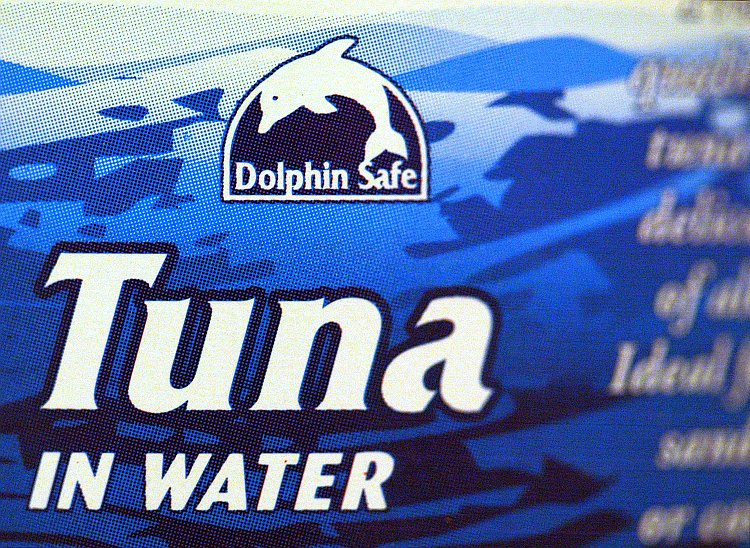The United States has been embroiled in a tuna-related trade dispute with Mexico for over two decades. Ever since the United States began awarding dolphin-safe labels to qualifying tuna cans, the Mexican tuna industry has cried foul.
Mexico asserts that U.S. restrictions on tuna imports violate several World Trade Organization rules, claiming the measures forced more than a third of its tuna fleet to shut down. In Sept. 2011, a WTO panel agreed. Last week, the U.S. Trade Representative (USTR) responded with an appeal.
“Our dolphin-safe labeling measures for tuna products provide information for American consumers as they make food-purchasing decisions for their families,” said Andrea Mead, press secretary for the trade office, in a statement. “Our decision to appeal the WTO ruling in this case demonstrates the commitment of the United States to our dolphin-safe labeling measures.”
Until the 1950s, most tuna was line caught, but advances in net technology, combined with a reliable dolphin-tuna relationship, changed everything.
Dolphins are often found swimming among schools of tuna, giving fisherman a clear target for casting large nets. The enormous seine purse net proved far more efficient than the old line and pole, but dolphins became an unfortunate casualty in its tuna harvest. The fishing technique resulted in millions of dolphin deaths and led to a U.S. tuna boycott in the 1980s.
Since then, American tuna consumers have sought out the dolphin-safe label to ensure that the can they purchase isn’t contributing to large numbers of dolphin deaths. Tuna sold in the United States must provide documentary evidence to don the dolphin-safe label.
U.S. labeling authorities say Mexico and several other countries still cruelly exploit the tuna-dolphin relationship, allowing their tuna industries to continue the practice of deliberately targeting, chasing, and surrounding dolphins with nets in their tuna harvesting. But Mexico, the nation with the largest fleet of purse seines, insists that U.S. labeling requirements are inconsistent and vary depending on harvest area and fishing method.
This fish bone of contention extends back to 1990, when the U.S. government first introduced the dolphin-safe label. In 2009, the Mexican government filed a complaint with the WTO challenging U.S. label requirements. In 2010, the U.S. took steps to transfer the case to NAFTA, but Mexico refused.
In last year’s ruling, the WTO panel concluded that U.S. objectives aimed at avoiding harm to dolphins were legitimate, and found that Mexican fishing techniques failed to meet these objectives. However, the WTO decided that U.S. labeling provisions are more trade-restrictive than necessary to fulfill these objectives.
The WTO says that if the U.S. arguments were accepted, then any country could ban imports from another country “merely because the exporting country has different environmental, health, and social policies from its own.” According to the WTO panel, this would allow nations to apply trade restrictions unilaterally, and their own standards on other countries.
“The door would be opened to a possible flood of protectionist abuses,” the WTO panel stated.
But according to the Earth Island Institute—a group monitoring tuna companies around the world for dolphin-safe standards—over 90 percent of the world’s tuna canners are able to effectively meet label requirements. They say that Mexico’s tuna industry won’t even participate—as they repeatedly refuse to sign a dolphin-safe tuna policy.
“The Dolphin-Safe tuna label has saved millions of dolphins from drowning in tuna nets,” said David Phillips, executive director of Earth Island Institute, in a statement following the WTO ruling. “It should not be weakened due to trade bias and false claims by Mexico and other nations.”
Earth Island adds that the WTO mistakenly calls the U.S. label mandatory, while in fact U.S. law makes the dolphin-safe label a voluntary system.
“The Dolphin-Safe tuna program is one of the most popular and successful environmental efforts for consumers in the world,” added Phillips. “More than 7 million dolphins have been killed due to Mexico’s and other countries’ focus on chasing and netting dolphins to catch tuna, and that fishing method must end.”
Although the U.S. is appealing the ruling, those with an eye for track records say the WTO is not likely to change its mind. The WTO rarely reverses its decisions, and the United States has so far lost all cases brought against its public interest laws.







